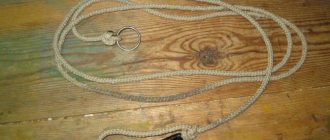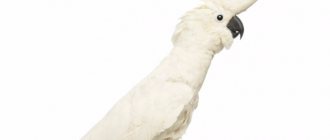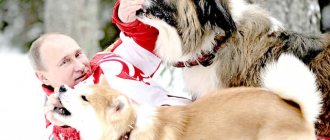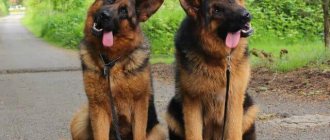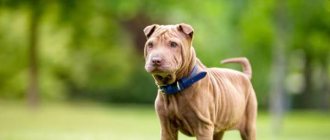A guide dog, or, as experts in this field say, a guide dog, is an unconditional assistant for a visually impaired person , helping him to move outside the confines of an apartment or house with the greatest possible safety. The main task of such a dog is to guide the owner along the road, choose the safest trajectory and warn about all obstacles along the way. Obstacles include concrete vehicle barriers, fences, stairs, ledges or steps, low tree branches or low-hanging wires, traffic lights, trenches, etc. and so on. At these and any other obstacles, the dog stops and waits until its owner, using a white cane, examines the object and understands what it is and how to get around it. And only after the person gives the command, the animal continues to move.
In everyday speech, the variant “guide dog” is much more common, but from the point of view of professionals, these animals are called “guide dogs”. Therefore, if you are talking to experts, it is better to choose a more formal wording.
Guide dogs are taught to walk half a length ahead of the owner, and he leads her on a special harness with a rigid arc , which allows him to better feel the pet. However, this is only a small part of what guides are taught. In Russia, several specialized centers are engaged in their preparation. One of the most famous is located near Moscow - in the Kupavna microdistrict of the city of Balashikha. The full name of this is (RSHPSP VOS). Another large center for guide dogs is located in the same Balashikha, but in Zheleznodorozhny - this is a training and cynological center (a shorter version is “Assistance Dogs”).
Using the examples of these schools, we propose to consider how guide dogs are trained. Of course, the training programs are similar in many ways, because similar requirements are imposed on guides.
The first book on training guide dogs was published back in 1819. However, the most active development of this area occurred in the post-war period - to help those who lost their sight in battles. In Europe this is the First World War, in the USSR it is the Great Patriotic War.
History of guide dogs
The concept of a “guide dog” first appeared in the 16th century. And the first special schools for training guide dogs began to open in the 20th century. in Germany at the end of the First World War.
Specially trained dogs helped veterans who lost their sight in the war. Then similar schools began to open in America, Great Britain and in the middle of the 20th century. in Russia.
According to the rules, guide dogs are called guide dogs.
Availability
Guide Dog Israel
Despite regulations or rules prohibiting access to animals in restaurants and other public places, in many countries service animals are protected by law and therefore can accompany their handlers in most places open to the public. Laws and regulations vary around the world:
- In the United States, the Americans with Disabilities Act prohibits any business, government agency, or other organization that provides access to the general public from prohibiting the use of service animals unless their presence would pose a health or safety risk. However, religious organizations are not required to provide such access. Whether service animals in training have the same rights or not is usually up to each state government. In addition, the Fair Housing Act requires that landlords allow tenants to have service animals, as well as other types of service animals, in residential buildings that generally have
a no-pet
policy and that such tenants cannot be charged additional fees. The Department of Housing and Urban Development's Office of Fair Housing and Equal Opportunity investigates complaints from the public alleging denials of reasonable accommodation requests related to animal assistance. - In the United Kingdom, the Equality Act 2010 provides that disabled people have the same right to services provided by shops, banks, hotels, libraries, pubs, taxis and restaurants as everyone else. Providers to accommodate service animals and service animal owners. Under Part 12 EA, it is illegal for service animal owners to deny access to a taxi or mini-cab with their service animal, but medical benefits are available if drivers have a certificate from their GPs.
- In most South American countries and Mexico, access to service animals depends solely on the goodwill of the owner or manager. In areas with a lot of tourists, service animals are usually accepted without problems. In Brazil, however, a 2006 federal decree requires that service animals be allowed in all public places. Metro Brasília has developed a program that trains service animals to ride on it.
- In Malta, the Equal Opportunities Act 2000 (Cap. 413) states that it is unlawful to discriminate against a person with a disability who requires an assistant, in this case a service animal. The exceptions are restaurant kitchens, special hospital rooms, toilets and rooms where other animals are kept.
- In Australia, the Disability Discrimination Act 1992 protects service animal owners. Each state and territory has its own laws, which may vary slightly.
- In Canada, service animals are allowed wherever the general public is permitted. Service Animal Laws by Province: Alberta: Blind Rights Act, Service Dog Act
- British Columbia: Guide Animal Act
- Manitoba: Human Rights Code, Service Animal Protection Act
- New Brunswick: Human Rights Act
- Newfoundland and Labrador: Blind Rights Act, Human Rights Act
- Northwest Territories: Human Rights Act
- Nova Scotia: Blind People's Rights Act, Human Rights Act
- Nunavut: Human Rights Act
- Ontario: Blind People's Rights Act, Accessibility for Ontarians with Disabilities Act, Human Rights Code
- Prince Edward Island: Human Rights Act
- Quebec: Persons with Disabilities Act, Charter of Human Rights and Freedoms
- Saskatchewan: Human Rights Code
- Yukon: Human Rights Act
Responsibilities of guide dogs
Guide dogs are trained in various skills. One of the main responsibilities is the protection of the owner in a public place.
- A guide dog for the blind can guide its owner along the safest route, skillfully avoiding obstacles and warning the owner about stairs, tree branches, fences and other restrictions. Dogs not trained in this skill do not pay attention to various obstacles.
- In addition to all of the above, these animals undergo perfect training, have the ability to pick up and hand fallen things to the owner, and help to get out of public transport.
Another skill that is taught in training courses is refusal to obey if the owner is in danger. Guide dogs know how to make decisions.
Purpose
Not every dog can become a guide dog. Half of the students drop out during the first classes. Guide dogs must have certain personality traits, including being friendly towards people. The best guides grow from puppies whose parents served as blind people, since their natural qualities are enhanced by genetic memory.
Guide dogs perform the following functions:
- accompany a blind person along the chosen route;
- help a disabled person adapt to environmental conditions;
- ensure the safety of the owner;
- provide psychological support.
When leaving the house, the dog begins to take care of the person so that he does not get into trouble. The dog barks to warn of obstacles along the way, including puddles, traffic lights, benches, stairs, and closed doors. In addition, such animals know how to look for the entrance, the way back from the metro, and pick up things dropped by the owner. Another task that the guide must perform is to remember the most common routes and lead the blind person to the right place without deviating from the path.
Breeds suitable for the role of guides
In order to become a guide, a dog must have certain character traits. But in reality, in practice you can understand which dogs are guide dogs and which are not.
For the most part, large, hardy breeds are easier to train than other animals.
The best guide dogs are animals with the following character traits:
- Resourcefulness and intelligence.
- Restrained character, the ability to restrain innate abilities.
- Resistance to stress.
- Excellent eyesight and sense of smell.
- Loyalty to the owner.
Saint Bernard
These large dogs (up to 70 cm at the withers) have the same big and kind hearts, prudence and rescue skills. A kind of hero of our time. Behind the thick fur and deep brown eyes lies excellent self-control and a willingness to always come to the aid of its owner. However, not everyone can find an approach to a St. Bernard - a dog will be able to fully open up and love a person if it becomes a real member of the family. Thus, a person acquires not just a guide, but a true, faithful friend.
Collie
A collie is a dog with an innate instinct to protect its owner.
- Animals of this breed are brave and determined, but at the same time warm and good-natured, they get along well with children, so they can become their best helpers.
- They are medium in size, which is an important quality for guide dogs.
- They are highly trainable, do not pay attention to extraneous sounds, and are not distracted by what is happening around them.
Enrolled in school
Dogs that instructors consider capable and trainable begin to be trained at approximately one year of age. Preparation consists of general and special parts. As part of the general course, the future guide is taught to perform well-known commands: “sit”, “lie down”, “fu”, “fetch”, “place”, “near” and so on. And a special course is guiding a blind person, when the dog is in a harness, a collar with a handle that the blind person holds on to.
The most difficult thing is to train a dog not to get lost in crowded places - for example, in the subway. For this purpose, animals are periodically taken to the city and trained, as they say, in combat conditions. The most dangerous thing is the escalator - when leaving it, the legs can be pulled under the comb. Then severe injury is inevitable. Therefore, guides are taught to jump over this place. The second most important point is not to react to strangers holding out treats. This distracts from the service, and the sausage may turn out to be “smelly.” The third point is stopping in front of an obstacle
It doesn’t matter whether the roadway ahead, a pole or a tree - the dog must stand rooted to the spot.
Before becoming a guide, dogs undergo training and pass exams. Photo: Egor Prosvirnikov
On the obstacle course, future guides are deliberately provoked to make mistakes. For example, there is a hatch on the sidewalk ahead, and the animal is being forcefully dragged forward. The dog should push with all its weight. “If he completes the task, we give him a tasty treat. Over time, we reduce the frequency of bait, and the dog passes the strip on its own without additional motivation,” says instructor Natalya Khashchevskaya, handing Ethel a piece of cheese
It is equally important to teach a dog to correctly guide a blind person to buses, trolleybuses and trams. For this purpose, the school even has a training “Pazik”
The guide carefully leads the blind man to the open door
Looking for a free place in the cabin for him
The guide carefully leads the blind man to the open door. He is looking for a free place in the cabin for him. The shepherd Hugo also copes with all tasks
He is much older than his classmates - he is already a year and a half old. “We often hand over shepherd dogs closer to two years of age, and Labradors are usually ready to serve for more than a year; they learn the program faster,” says Khashchevskaya
The shepherd Hugo also copes with all tasks. He is much older than his classmates - he is already a year and a half old. “We often transfer shepherd dogs closer to two years, and Labradors are usually already ready to serve for more than a year, they learn the program faster,” says Khashchevskaya.
The worst irritant for guides is, of course, other animals. Especially cats. To prevent dogs from reacting to them, the school has a “program” for working out their indifference to furry animals, which is not typical for them. Here, as if at home, the cat Batman walks freely and sometimes even tries to bully his “colleagues.” The conductors do not pay attention to him at all - the endurance is steel.
At the end of the training, the dogs take an exam. You need to not get confused on the site and in the city. Moreover, the examiner is a stranger - an instructor who did not train them. This creates additional stress.
Not only the conductor, but also the blind person undergoes training and testing of knowledge. “When the dog is ready, we invite the disabled person to our school for training. It goes away within two weeks. An experienced instructor-methodologist teaches the dog and the disabled person how to interact. All this time a person lives here, we provide three meals a day and a roof over his head. At the same time, travel to school is also paid,” says Andrei Ivashkov, deputy director of the school for social issues.
At the very end, the blind person is tested. If a common language is found with the dog, then they will return home together. From this moment on, the dog belongs to the disabled person under a free use agreement.
Help "RG"
Golden retriever
From the photos of guide dogs it can be seen that they all have similar traits.
- The Golden Retriever is a breed that is trained to support visually impaired and blind people more often than others.
- By nature, these dogs are very docile, and during the hunt they can bring live prey to the owner without injuring it.
- They are brave, intelligent, observant, submissive animals.
Their only drawback is their long hair, which can make it difficult for a blind owner to care for. But if the owner finds a way to care, then a golden retriever is the best option for both children and adults.
Bernese Mountain Dog
These are hardy, active, peace-loving and cheerful dogs that are ready to give their blind owner a boost of energy and happiness. However, once on the street in a specialized harness, the funny pet will be unrecognizable. He instantly transforms into an obedient, balanced and reasonable dog, clearly in control of his surroundings. It is quite easy to train, but you have to be persistent.
Labrador
These are friendly, easy to train animals and are considered the best guide dogs. Due to their characteristics, it will not be difficult for them to switch from the instructor to the owner and establish a connection with him.
- This is a companion animal and has good stress resistance.
- Labradors are brave and friendly.
- They are very calm, and most blind people choose them.
- In addition to all these qualities, they have good health and live up to 18 years.
- This breed exhibits virtually no hostility; they communicate well with adults and children.
The training of these animals takes place effortlessly, up to about one and a half years. Another advantage of Labradors is their ideal size, thanks to which it will be easy for the owner to hold on to the harness.
Russian Spaniel
The Russian Spaniel is perfect for any family. These dogs adapt perfectly to the conditions of a small apartment, quickly get used to it and from the very first seconds begin to help their owner. They are smart, easy to train and will happily follow a command, which is typical of all spaniels. Loyal, kind, reliable, dutiful - these characteristics best describe the representatives of this breed. Small and quite active, they definitely won’t let you get bored and will become an integral part of everyone’s life.
Boundless love for humans, devotion and fidelity make representatives of the listed breeds the best friends who will always help in a difficult situation.
German Shepherd
This breed is distinguished by good mental abilities and loyalty.
- Their intelligence and tenacity make them well suited for the role of a guide dog, and their courage makes them good guard dogs.
- Their resilience helps them work in even the coldest conditions, but unlike Labradors, they need more time to bond with their new owner.
Tervuren
This breed has the most important qualities for guide dogs:
- training speed;
- obedience;
- attentiveness;
- bravery;
- ability to analyze a situation and make a decision;
- activity and good character.
Having become a loyal friend and support for a person with disabilities, he will become a brave defender. Tervurens prefer to be the only favorite in the family, so it is better to refuse other animals, but they always feel warm love for children.
They have a strong character, so it is important to start raising them from the very first moments of acquaintance.
Rottweiler
In the past, when Labradors were not so popular as guide dogs, Rottweilers were often used.
- In addition to loyalty, they have courage and perseverance.
- They need serious training and education, thanks to which they make excellent guide dogs.
- In addition to guides, they are excellent guards.
- These dogs are suitable for people with a strong character, as they may tend to be dominant.
Poodle
The Royal or Standard Poodle grows 45-60 cm and has a kind, unpretentious disposition. A trained dog is suitable even for a novice dog breeder. Observation and interest in interacting with a person facilitates the learning process. They easily remember new routes and unquestioningly and happily follow their owner’s commands. If a person needs the help of a dog, he immediately rushes to the rescue and does everything possible to make the owner happy and satisfied. In addition, they will not let you get bored, actively supporting the games, and are happy to make contact.
Doberman
Dobermans are very playful animals, so it is best to choose them for children.
- These dogs need to be walked and played a lot.
- A distinctive feature is calmness, as well as wariness towards strangers.
- Their advantage is that they adapt to the owner and guess his mood.
Stages of training guide dogs
- Dogs are trained from 1.5 months. Already at this age, instructors select contact puppies. The main requirements are that the dog must tolerate any noise well and not show its instincts too much.
- At 6-7 months, dogs begin to be driven around the city and come into contact with people. Dogs need to show themselves in a friendly manner in response to touch, since otherwise the future visually impaired owner will not be able to come into contact with him.
- At the last stage, the dogs are trained according to the correct behavior of guide dogs. From the age of one to one and a half years, special training begins. It involves learning the “fetch” command, moving with the future owner along a given path, and the ability to avoid obstacles. This stage ends with a kind of exam for the dog with two instructors: one of them wearing special glasses that deprive him of vision, and the second observing the accuracy of the guide dog’s work.
Methods of preparation for work
The main task of guides is to study and remember routes so that the owner can easily get to the desired point, be it a store or work. In order for the dog to cope with its duties, it is taught the following commands:
- moving in front of the owner, turning;
- stopping when obstacles appear and further walking around (in this case, the dog must notify the owner about the obstacle).
Command training is carried out at training grounds with the help of professional dog handlers. A man holds a cane for the blind in his hands and moves along a trajectory. When an obstacle appears, the command “Stop” is given and the trainer hits the obstacle with a stick. Training is carried out until the animal begins to respond correctly to commands. When the dog learns to cope with these tasks, they move on to the next stage - moving between objects, going up and down stairs, driving along the streets. Students are taught basic commands and the names of various places: house, store, park.
The capabilities of a guide dog
A guide dog may disobey its owner and make a decision on its own if it sees that the owner is in danger. She can stop when a car approaches them, protecting herself and her owner.
A guide dog cannot distinguish between the colors of traffic lights and cannot explore unfamiliar territory. Its task is to guide its owner along a given path in the safest possible way.
Features of addiction
Transferring the animal to a new owner is the third and very important stage, which is called habituation. It is at this moment that it becomes clear whether they are suitable for each other. A guide dog spends a long time learning to lead a blind person down the street. During the adjustment period, the dog handler will be close to the dog and the disabled person.
The new owner needs to spend as much time as possible with their pet. A guide dog is no different from ordinary dogs; he also loves praise and will be happy to receive a treat for obedience. This is important to consider during the adaptation stage. You need to talk to your dog as often as possible so that it remembers your voice. Cases where the owner and the dog do not suit each other are very rare.
The cost of the animal and the right to receive
Guide dogs are provided free of charge to everyone with group I visual impairment. But you will have to wait your turn, which usually takes about 6 months. For those who don't want to wait, you can buy an animal.
The price for a guide dog ranges from 250-400 thousand rubles. The second option is to purchase the animal yourself and send it to training. The cost of training is approximately 60 thousand rubles.
